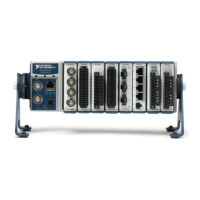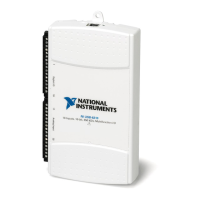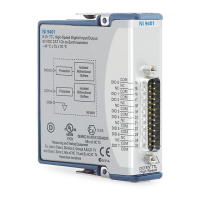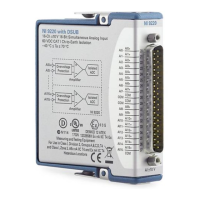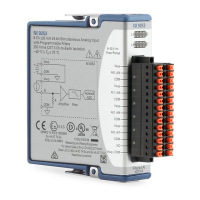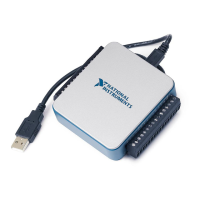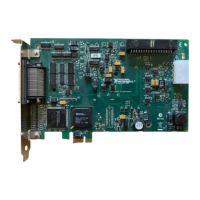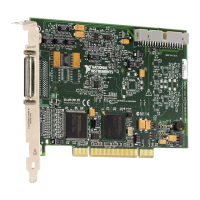Chapter 6 Digital I/O
© National Instruments 6-15 X Series User Manual
Note (NI USB-634x/635x/636x Devices) X Series USB devices do not support
hardware-timed single point (HWTSP) operations.
• Buffered—In a buffered generation, data is moved from a PC buffer to
the DAQ device’s onboard FIFO using DMA before it is written to the
output lines one sample at a time. Buffered generation typically allow
for much faster transfer rates than non-buffered acquisitions because
data is moved in large blocks, rather than one point at a time.
One property of buffered I/O operations is the sample mode. The
sample mode can be either finite or continuous:
– Finite sample mode generation refers to the generation of a specific,
predetermined number of data samples. Once the specified number
of samples has been written out, the generation stops.
– Continuous generation refers to the generation of an unspecified
number of samples. Instead of generating a set number of data
samples and stopping, a continuous generation continues until you
stop the operation. There are several different methods of
continuous generation that control what data is written. These
methods are regeneration, FIFO regeneration and
non-regeneration modes:
• Regeneration is the repetition of the data that is already in the
buffer. Standard regeneration is when data from the PC buffer
is continually downloaded to the FIFO to be written out. New
data can be written to the PC buffer at any time without
disrupting the output. Use the NI-DAQmx write property
regenMode to allow (or not allow) regeneration. The
NI-DAQmx default is to allow regeneration.
• With non-regeneration, old data is not repeated. New data
must be continually written to the buffer. If the program does
not write new data to the buffer at a fast enough rate to keep
up with the generation, the buffer underflows and causes an
error.
• With FIFO regeneration, the entire buffer is downloaded to
the FIFO and regenerated from there. Once the data is
downloaded, new data cannot be written to the FIFO. To use
FIFO regeneration, the entire buffer must fit within the FIFO
size. The advantage of using FIFO regeneration is that it does
not require communication with the main host memory once
the operation is started, thereby preventing any problems that
may occ
ur due to e
xcessive bus traff
ic. Use the NI-DAQmx
DO channel property, UseOnlyOnBoardMemeory to enable
or disable FIFO regeneration.
Artisan Technology Group - Quality Instrumentation ... Guaranteed | (888) 88-SOURCE | www.artisantg.com
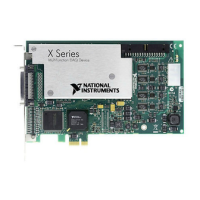
